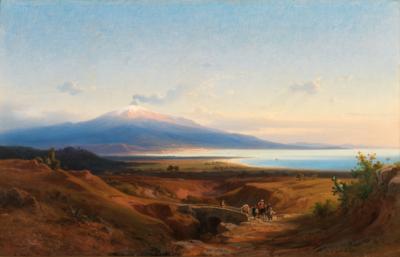Antal Ligeti

(Nagykaroly 1823–1899 Budapest)
Travellers in Catania, with Etna in the Background, signed, dated Ligeti A. 1870, oil on canvas, 43.5 x 68.5 cm, framed
Born into a Hungarian merchant family with no artistic aspirations, Antal Ligeti’s success as a landscape painter is even more impressive. Ligeti travelled through Italy settling for a time in Naples and later Florence, where he met Hungarian painter Karoly Marko, who became his mentor and teacher. After a brief period spent in Munich, he returned to Hungary to fight in the Hungarian revolution of 1848. Later while living in Sopron, Ligeti also attempted to make a living from his portrait paintings, but quickly moved to Pest and returned to landscapes when unsuccessful to do so. Count Istvan Karolyi became a fervent patron of Ligeti, allowing him to reside in his palace in Fót and financing various expeditions to Egypt, Palestine, Italy, Syria, Cyprus and Malta. During his 1855 travels, Ligeti created a large number of sketches, many of which were later used for some of his most successful paintings. Ligeti’s success later allowed him to establish a studio and become a reputed curator at the Hungarian National Gallery.
Dated 1870, this work is painted after one of his sketches of Catania and Etna. Inspired by Romanticism, he created depth through atmospheric perspective, with Etna fading into the background. The volcano was active throughout the nineteenth century, explaining why Ligeti chose to paint smoke. By adding human figures, Ligeti also included movement which allowed the viewer to imagine a narrative.
Expert: Mag. Dimitra Reimüller
 Mag. Dimitra Reimüller
Mag. Dimitra Reimüller
+43-1-515 60-355
19c.paintings@dorotheum.at
02.05.2023 - 18:00
- Odhadní cena:
-
EUR 20.000,- do EUR 25.000,-
Antal Ligeti
(Nagykaroly 1823–1899 Budapest)
Travellers in Catania, with Etna in the Background, signed, dated Ligeti A. 1870, oil on canvas, 43.5 x 68.5 cm, framed
Born into a Hungarian merchant family with no artistic aspirations, Antal Ligeti’s success as a landscape painter is even more impressive. Ligeti travelled through Italy settling for a time in Naples and later Florence, where he met Hungarian painter Karoly Marko, who became his mentor and teacher. After a brief period spent in Munich, he returned to Hungary to fight in the Hungarian revolution of 1848. Later while living in Sopron, Ligeti also attempted to make a living from his portrait paintings, but quickly moved to Pest and returned to landscapes when unsuccessful to do so. Count Istvan Karolyi became a fervent patron of Ligeti, allowing him to reside in his palace in Fót and financing various expeditions to Egypt, Palestine, Italy, Syria, Cyprus and Malta. During his 1855 travels, Ligeti created a large number of sketches, many of which were later used for some of his most successful paintings. Ligeti’s success later allowed him to establish a studio and become a reputed curator at the Hungarian National Gallery.
Dated 1870, this work is painted after one of his sketches of Catania and Etna. Inspired by Romanticism, he created depth through atmospheric perspective, with Etna fading into the background. The volcano was active throughout the nineteenth century, explaining why Ligeti chose to paint smoke. By adding human figures, Ligeti also included movement which allowed the viewer to imagine a narrative.
Expert: Mag. Dimitra Reimüller
 Mag. Dimitra Reimüller
Mag. Dimitra Reimüller
+43-1-515 60-355
19c.paintings@dorotheum.at
|
Horká linka kupujících
Po-Pá: 10.00 - 17.00
kundendienst@dorotheum.at +43 1 515 60 200 |
| Aukce: | Obrazy 19. století |
| Typ aukce: | Sálová aukce s Live bidding |
| Datum: | 02.05.2023 - 18:00 |
| Místo konání aukce: | Wien | Palais Dorotheum |
| Prohlídka: | 22.04. - 02.05.2023 |
Všechny objekty umělce
